Here you will find NCERT solutions for class 10 Science Chapter 3 notes containing all the main and important topics which have a complete and detailed description. NCERT solutions for class 10 Science Chapter 3 notes will help the students of class 10 to understand concepts. If you want to secure good marks in the examinations, you must go through all activities prescribed in the chapter.
You will be able to download the Metals and non-metals class 10 NCERT pdf.
NCERT solutions for class 10 Science Chapter 3 notes cover the complete syllabus and let you secure the best results in CBSE and other board exams. NCERT solutions for class 10 Science Chapter 3 notes will help you to solve homework and home assignments in an easy way.
The students can download NCERT Solutions for Class 10 Science Chapter 3PDf format for offline use.
NCERT Solutions for Class 10 Science Chapter 3 notes
You must know the topics and subtopics of Chapter 3 Metals and Non-Metals of NCERT Science for Class 10 before you go through the Solutions of Chapter 3 Metals and Nonmetals of NCERT Science for Class 10.
1. Physical Properties
2. Chemical Properties of Metals
i. What happens when Metals are burnt in Air?
ii. What happens when Metals react with water?
iii. What happens when Metals react with Acids?
iv. How do Metals react with Solutions of other Metal salts?
v. The Reactive Series
3. How Do Metals and Non- metals React?
i.Properties of Ionic Compounds
4. Occurrence of Metals
i.Extraction of Metals
ii. Enrichment of Ores
iii. Extracting Metals low in the Activity Series
iv. Extracting Metals in the middle of the Activity Series
v.Extracting Metals towards the Top of the Activity Series
vi. Refining of Metals
5. Corrosion
i.Prevention of Corrosion
Table of contents
Metals and non-metals class 10 NCERT exercise solutions
TEXTBOOK QUESTIONS of Chapter 3
Questions (Page 40)
(i) is a liquid at room temperature;
(ii)can be easily cut with a knife;
Ans.-
(iii). Metal that is the best conductor of heat- Silver(Ag)
(iv) Metal that are poor conductors of heat – Lead (Pb)
Q.2Explain the
meaning of malleable and ductile.
Ans. Malleable: Substances
that can be beaten into thin sheets are called malleable.
For example- most of the metals are malleable.
Ductile: Substances that can
be drawn into thin wires are called ductile.
For example- most of the metals are ductile.
Questions (Page 46)
Q.1Why sodium is kept immersed in kerosene oil?
Ans. Sodium is a highly reactive metal and it combines
with moisture present in the air and catches fire if kept in open. Therefore,
to prevent accidental fires, it is kept immersed in kerosene oil.
Q.2 Write equations
for the reaction of
(i) iron with steam (ii) Calcium and
potassium with water.
Ans.
(i).3Fe+ 4 H2O(g)→Fe3O4(s)4H2(g)
(ii).Ca(s)+2H2O(l) →Ca(OH)2(aq)+H2(g)
(iii).2K +2H2O(l) →2KOH(aq) +H2(g)
Q.3 Samples of four
metals A, B, C, and D were taken and added to the following solution one by one.
The results obtained have been tabulated as follows:

Ans. (i). The most reactive metal- B
(ii). When metal B is added to copper sulphate solution, it displaces copper from its solution.
(iii) B > A > C > D
Q.4Which gas is
produced when dilute hydrochloric acid is added to a reactive metal? Write the
chemical equation when iron reacts with dilute H2SO4.
Ans. Hydrogen gas is produced when dilute
hydrochloric acid reacts with a reactive metal.
Fe + H2SO4 → FeSO4 +H2↑
Q.5What would you
observe when Zinc is added to a solution of Iron (II) sulphate. Write the
chemical reaction that takes place.
Ans.When Zinc is added to a solution of Iron (II)
sulphate, it will displace iron from its aqueous solution.
Zn(s)+FeSO4(aq) → ZnSO4(aq) +Fe(s)
Questions (Page 49)
Q.1 (i) Write electron-dot structures for sodium, oxygen and magnesium.
(ii) Show the formation of Na2O and MgO by the transfer of electron
(iii) What are the ions present in these compounds?
Ans. (i). Electron dot structures for sodium,
oxygen, and Magnesium
(ii). Formation of Na2O
and MgO by the transfer of electrons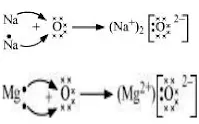
(iii). Na+ and`\O^-2`ions in `\Na_2O`and `\Mg^2+`and `\O^-2` are present in these compounds.
Q.2Why do ionic
compounds have high melting points?
Ans. Ionic compounds are formed by
oppositely charged ions so these compounds have strong electrostatic forces of
attraction between the ions. Therefore, it requires a lot of energy to overcome
these forces. That is why ionic compounds have high melting points.
Questions (Page 53)
(a)Mineral, (b)
ore and (c) gangue.
Ans. (i) Mineral.-Most of the
elements occur in nature as compounds and
they have fixed chemical composition, they are called
minerals.
(ii) Ore.- The mineral from which a metal can be extracted profitably
and easily is called ore.
(iii) Gangue.-The impurity of sand and rocky materials present in the
ore is known as gangue.
Ans. Gold and Silver
Q.3What chemical
process is used for obtaining a metal from its oxide?
Ans. Reduction process is used for obtaining a
metal from its oxide. In this process, metal oxides are reduced by
using suitable reducing agents such as carbon or by highly reactive metals to
displace the metals from their oxides.
Questions (Page 55)
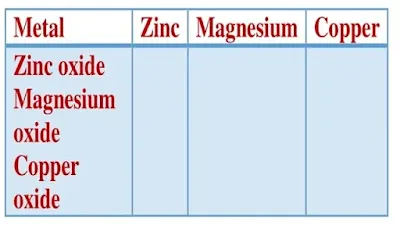
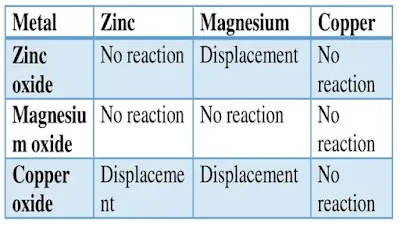
Q.2 Which metals do not corrode easily?
Ans. Gold and platinum do not corrode easily.
Q.3 What are alloys?
Ans. Alloy. “An alloy is a homogenous solid
solution of one metal with one or more metals or non-metals, such as brass,
bronze etc.”.
NCERT Solutions for Class10 Science Chapter 3 Metals and Non-Metals
NCERT Class 10 Science Chapter 3 Exercise solutions
Q.1 Which of the
following Pairs will give displacement reactions
(a) NaCl solution and copper metal
(b)MgCl2
solution and aluminium metal
(c) FeSO4
solution and silver metal
(d) AgNO3
solution and copper metal
Ans. (d)AgNO3
solution and copper metal
Q.2 Which of The following methods is suitable for preventing an iron frying pan from rusting.
(a) applying grease (b) applying
paint
(c) applying
a coating of zinc (d) all of the above
Ans. (c) applying
a coating of zinc
Q.3An element
reacts with oxygen to give a compound with a high melting point. This compound
is also soluble in water. The element is likely to be
(a) calcium (b) carbon
(c)silicon (d) iron
Ans. (c) calcium
Q.4Food cans are
coated with tin and not with zinc because-
(a) zinc is costlier than tin
(b)zinc
has a higher melting point than tin
(c)zinc
is more reactive than tin
(d)zinc
is less reactive than tin
Ans. (c) zinc
is more reactive than tin
Q.5 You are given a
hammer, a battery, a bulb, wires, and a switch.
(a) How would you use them to distinguish between
samples of metals and non-metals.
(b) Assess the usefulness of these tests in
distinguishing between metals and non-metals.
Ans. (a) (i) Beat the sample with a hammer if it
does not break and change into a sheet it is metal and if it breaks on hammering
it is non-metal.
(ii) we can use the battery, bulb,
wires, and a switch to set up a circuit with the sample. If the sample conducts
electricity, then it is a metal and if the bulb does not glow then it is a non-metal.
(b). The above tests are useful in
distinguishing between metals and non-metals as these are based on physical properties. No chemical reactions are involved in these
tests.
Q.6 What is
amphoteric oxide? Give examples of two amphoteric oxides.
Ans. The oxides which show acidic and basic characters and react with bases and acids to form salt and water are called
amphoteric oxides. e.g.Aluminum oxide[Al2O3] and zinc
oxide[ZnO]
Al2O3 + 6HCl→2AlCl3 +3H2O
Al2O3 +2NaOH→ 2AlNaO2+ H2O
Q.7 Name two metals
that displace hydrogen from dilute acids and two metals which will not.
Ans. Metals that displaces hydrogen from dilute acids:
Na & K
Metals which does not displace
hydrogen from dilute acids: Cu & Ag
Q.8 In the
electrolytic refining of a metal M, what would you take as the anode, cathode
and electrolyte?
Ans.
In the electrolyte refining of a metal M –
Anode → impure metal M
Cathode → thin strip of pure metal M
Electrolyte → Solution of salt of the
metal M
Q.9 Pratyush took
sulphure powder on a spatula and heated it. He collected the gas evolved by
inverting a test tube over it as shown in Fig. below:
(a)What will be the action of gas on?
(i) dry litmus paper?
(ii) Moist litmus paper?
(b) Write
a balanced chemical equation for the reaction taking place.
Ans. (a) (i) There will be no action of gas on dry
litmus paper.
(ii) On moist litmus paper, the gas will change it to red.
(b) S(s) + O2(g) →SO2
Q.10State two ways to
prevent the rusting of iron.
Ans.(i) Oiling,
greasing, or painting: By applying oil, grease, or paint, the surface
becomes waterproof and the moisture and oxygen present in the air cannot come
into direct contact with iron. So by this method rusting is prevented.
(ii) Galvanisation: An iron article is
coated with a layer of zinc metal, which prevents
the iron to come in contact with oxygen and moisture. By this method
rusting is prevented.
Q.11What type of
oxides formed when non-metals combine with oxygen?
Ans. Acidic oxides are formed when non-metals
combine with oxygen.
S + O2 → SO2
Q.12 Give reasons:
(a) Platinum,
gold and silver are used to make jewellery.
(b) Sodium,
potassium and lithium are stored under oil.
(c) Aluminum is a highly reactive metal; still, it is used to make utensils
for cooking.
(d) Carbonate
and sulphide ores are usually converted into oxides during the process of
extraction.
Ans. (a) Platinum, gold, and silver do not react with
atmospheric and other reagents and they are very lustrous so they are used to
make jewellery.
(b)Sodium, potassium, and lithium are stored under oil, because they are highly reactive and combine with atmospheric oxygen and catch fire when they are kept in the open air.
(c) Aluminum is a reactive metal, but it is
used to make utensils used for cooking because aluminum reacts with oxygen of
atmosphere to form aluminum oxide(Al2O3) which is
non-reactive and makes a sticky layer over it which prevents further reaction.
(d) Carbonate and sulphide ores are usually
converted to oxides because metals can be easily extracted from their oxides rather than
from their carbonates and sulphides
Q.13 You must have seen tarnished copper vessels being cleaned with lemon or tamarind juice. Explain why these sour substances are effective in cleaning the vessels.
Ans. Copper reacts with moist carbon dioxide in the air
to form copper carbonate and as a result, copper vessel loses its shiny brown
surface forming a green layer of copper carbonate. When these types of vessels
are cleaned with lemon or tamarind juice containing acids, the shining surface
again visible.
Q.14Differentiate
between metal and non-metal on the basis of their chemical properties.
Ans. Metal and non-metal show the following
differences in their chemical properties.
1. (a) Mostly the metals react with oxygen to form
basic oxides.
4Na +O2 →Na2O
2M+O2 →2MgO
(b) Non-metals react with oxygen to form
acidic oxides.
S+ O2→SO2
2. (a)Most of the metals react with water to form oxides and hydroxides
2Na +2H2O→2NaOH H2 ↑
(b) Non-metals do not
react with water
3. (a) Most of the metals react with dilute
acids to produce salt and hydrogen gas is evolved
2Na +2HCl→2NaCl H2 ↑
(b) Non-metals do not react with acids.
Q.15 A man went door to
door posing to be a goldsmith. He promised to give back the glitter to old and
dull gold ornaments. An unsuspecting housewife gave a set of gold bangles to
him which he dipped in a particular solution. The bangles sparkled like new but
their weight was reduced drastically. The lady was upset but after a futile
argument, the man beat a hasty retreat. Can you play the detective to find out
the nature of the solution he had used?
Ans. The man must have dipped the gold bangles
which is a mixture of conc. HCl and conc. HNO3in ration 3: 1
.this mixture is known as ‘ Aqua Regia’ which dissolves gold that’s why the
bangles sparkled like new due to the dissolving of gold, their weight was reduced.
Q.16 Give the reason why copper is used to make hot water tanks but steel (an alloy of iron) is not.
Ans. Copper does not react with cold water,
hot water, or steam, so it is used to make water tanks but steel an alloy of
iron is not used because iron reacts with hot water.
3 Fe + 4H2O→Fe3O4 + 4H2
That is why copper is used to making hot water tanks and not steel.
After reading chapter 3 Metals and non-metals class 10, you will be able to answer the questions as follows-
1. 1.What is metal class10?
Ans. Metals are electropositive elements and they release or donate
electrons from their outermost shell. So they form cations.
2. 2.What is non-metal class 10?
Ans. Non –metals are electro-negative
elements and they gain electrons and form anions.
3. 3. Is diamond a metal?
Ans. Diamond is the purest form of carbon. It crystalline allotrope of
carbon. Carbon is non-metal. Diamond is a conductor of electricity.
Remedial Education Point.com provides you
complete study material for class 10 absolutely free. Now you can get accurate
NCERT Book Solutions for Class 10 Science Chapter 3 Metals and Non- metals
prepared by our expert teachers.
- Chapter 1 Chemical Reactions and Equations
- Chapter 2 Acids, Bases, and Salts
- Chapter 3 Metals and Non-metals
- Chapter 5 Periodic Classification of Elements
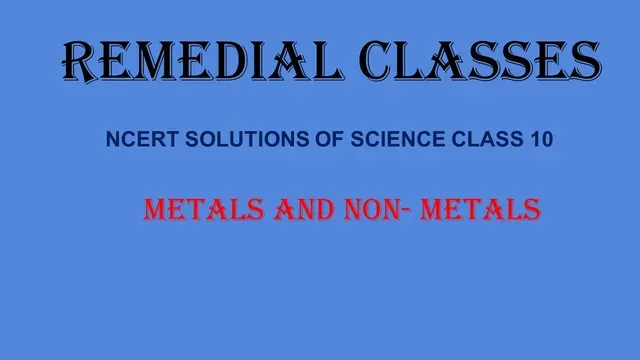
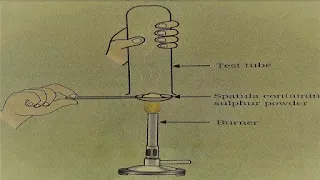




No comments:
Post a Comment